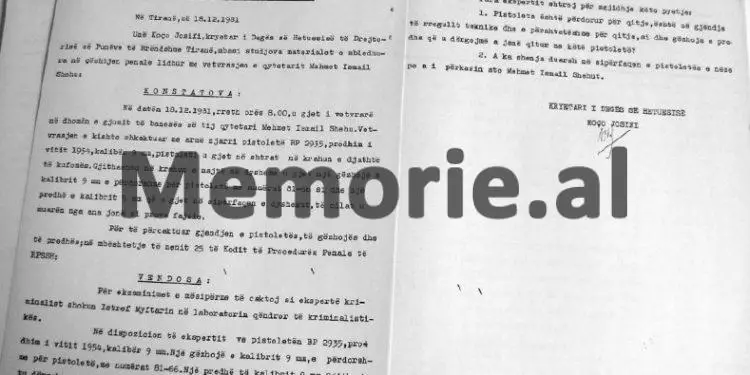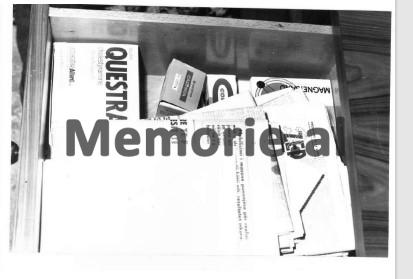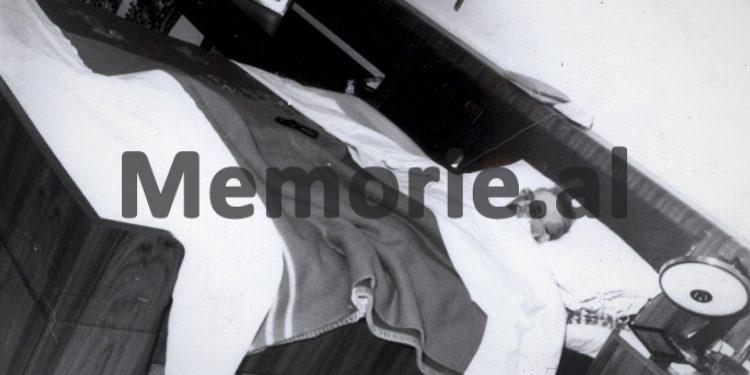By Dashnor Kaloçi
Part Three
Memorie.al / 43 years ago, on the morning of December 18, 1981, the Albanian Prime Minister Mehmet Shehu, who had held that position since 1953, was found dead in his bedroom (according to the official version, from a bullet from a “pistol”), in the villa where he lived with his family, at the entrance to the “Block” of the high leadership of the Albanian Party of Labor, just a few meters from the building of the Central Committee of the Party and also from Enver Hoxha’s villa. Although more than four decades have passed since that day, considered one of the most serious and scandalous events of that regime, even today there is no clear and accurate version regarding what happened to former Prime Minister Mehmet Shehu on the midnight transitioning to December 18, 1981! However, even after the 1990s, dozens of testimonies and archival documents have been made public concerning that event; “the murder or suicide of Mehmet Shehu” continues to be a subject of much debate and discussion, perhaps wrapping the truth surrounding it in even more mystery!
Given this fact, within the framework of publishing dozens of testimonies and archival documents from the secret fund of the former State Security and the Ministry of Internal Affairs, or from the Central Committee of the Party, which we have published in these three decades since the collapse of Enver Hoxha’s communist regime and that of his successor, Ramiz Alia, Memorie.al has secured the voluminous file of “the enemy Mehmet Shehu,” which has been extracted from the secret fund of the former State Security (at the Ministry of Internal Affairs), where, with a few small exceptions, the majority of them have never seen the light of publication and are being published for the first time.
In the mentioned file, the complete expert report of the investigative-operational group, established immediately on the morning of December 18, 1981, is found with its members, including Koço Josifi (head of the Investigation of the Directorate of Internal Affairs of Tirana), forensic doctors Dr. Fatos Harito and Docent Bashkim Çuberi, the doctors of the Prime Minister, Milto Kostaqi and Llesh Rroku, as well as the criminal expert from the Central Criminalistics Laboratory of the Ministry of Internal Affairs, Estref Myftari, assisted by senior officials of that ministry, Xhule Çiraku, Elham Gjika, and Lahedin Bardhi.
Additionally, the voluminous file that we are making public also contains the testimonies of the family members of former Prime Minister Mehmet Shehu, service personnel, and his escort group, as well as all the other individuals who were called and testified regarding that event. For more about this, etc., the documents in question inform us, which we are publishing together with their facsimiles and respective photos.
Continued from the previous issue
ARCHIVAL DOCUMENT WITH THE REPORT OF THE FORENSIC EXAMINATION OF THE BODY OF CITIZEN MEHMET ISMAIL SHEHU, BY FORENSIC EXPERTS DR. FATOS HARITO AND DOCENT BASHKIM ÇUBERI
FORENSIC ACT NO. 133
ON THE FORENSIC EXAMINATION OF THE BODY OF CITIZEN MEHMET SHEHU
CONCLUSIONS:
Based on the data above, we reach the following conclusions:
On the body of citizen Mehmet Shehu, a penetrating gunshot wound was found, with an entry hole in the left front of the chest and an exit hole in the left side of the back, with the characteristics mentioned in the descriptive section of this act. The aforementioned injuries were caused by a single gunshot from a distance with an incomplete trigger pull and with a direction from front to back, slightly from right to left. The victim’s death resulted from hemorrhagic shock, possibly caused by a rupture of the heart or large blood vessels emanating from it. The death is estimated to have occurred approximately 10-12 hours before the inspection of the body, which took place at noon.
FORENSIC EXPERTS
DR. FATOS HARITO DOC. BASHKIM ÇUBERI
ARCHIVAL DOCUMENT WITH THE DECISION FOR THE TECHNICAL-BALLISTIC AND DACTYLOSCOPIC EXAMINATION OF THE PISTOL, CARTRIDGES, AND BULLET FOUND IN THE BEDROOM OF CITIZEN MEHMET ISMAIL SHEHU, BY THE CHAIRMAN OF THE INVESTIGATION KOÇO JOSIFI
DECISION
ON THE TECHNICAL-BALLISTIC AND DACTYLOSCOPIC EXAMINATION
Tirana, December 18, 1981
I, Koço Josifi, chairman of the Investigation Branch of the Directorate of Internal Affairs of Tirana, having studied the materials collected regarding the criminal case of the suicide of citizen Mehmet Ismail Shehu;
FINDINGS:
On December 18, 1981, at approximately 8:00 AM, citizen Mehmet Ismail Shehu was found dead in his bedroom, having committed suicide with a firearm. The suicide was caused with a RP 2935 pistol, manufactured in 1954, caliber 9 mm. The pistol was found on the bed, on the right side of the corpse. Additionally, on the left side on the floor, a 9 mm cartridge used from the pistol with the numbers 51-86 was found, as well as a 9 mm bullet that was found on the surface of the mattress, which we took as evidence of guilt.
To determine the condition of the pistol, the cartridge, and the bullet, in accordance with Article 25 of the Penal Procedure Code of the People’s Socialist Republic of Albania:
IT IS DECIDED
To appoint forensic expert, comrade Estref Myftari at the Central Forensic Laboratory for the above examination.
At the disposal of the expert, I present the RP 2935 pistol, manufactured in 1954, caliber 9 mm. A 9 mm cartridge, useable for a pistol, with the numbers 81-86. A 9 mm bullet. The fingerprints of citizen Mehmet Ismail Shehu will also be sent for comparison.
I pose the following questions for the expert to address:
Has the pistol been used for shooting, is it in proper technical condition, and is it suitable for shooting?
Are the cartridge and bullet we send, fired from this pistol?
Are there fingerprints on the surface of the pistol, and if so, do they belong to citizen Mehmet Ismail Shehu?
CHAIRMAN OF THE INVESTIGATION BRANCH
KOÇO JOSIFI
ARCHIVAL DOCUMENT REPORT ON THE TECHNICAL-BALLISTIC AND DACTYLOSCOPIC EXAMINATION OF THE PISTOL, CARTRIDGES, AND BULLET FOUND IN THE BEDROOM OF CITIZEN MEHMET ISMAIL SHEHU, BY THE CHAIRMAN OF THE INVESTIGATION KOÇO JOSIFI
THE PEOPLE’S SOCIALIST REPUBLIC OF ALBANIA
MINISTRY OF INTERNAL AFFAIRS
CRIMINALISTICS LABORATORY Tirana, December 18, 1981
ACT – No. 206
Technical-ballistic and dactyloscopic examination
From the Investigation of the Directorate of Internal Affairs of Tirana, by the decision dated December 18, 1981, of investigator Koço Josifi, we received for examination:
The pistol RP 29-33, manufactured in 1954, caliber 9 mm.
A 9 mm caliber cartridge used for a pistol, numbered 81-66.
A 9 mm caliber bullet.
These material evidences were collected at the crime scene where Mehmet Shehu was found dead.
Also sent for comparison are the fingerprints of this person.
The examination aims to determine:
Whether the pistol has been used for shooting, whether it is in proper technical condition, and whether the cartridge and bullet were fired from this pistol.
Whether there are fingerprints on this pistol and, if so, do they belong to citizen Mehmet Ismail Shehu?
CRIMINALISTIC EXAMINATION
The pistol sent for examination is a military production from 1954, caliber 9 mm. It is a small-sized pistol with a fiber grip, in dark red color.
First, the pistol was examined to identify any fingerprints on its surface; for this purpose, it was treated with aluminum powder and it was determined that on the trigger guard, from the right, there was a circular fingerprint. Judging by the shape and position of this fingerprint, it appears to have been left by the thumb of the left hand.
After fixing this fingerprint, the pistol was examined in its assembled state. It was then disassembled to determine its technical condition and suitability for shooting. From this examination, it was found that the pistol has all the necessary parts and mechanisms in very good condition, unused and unaltered. From the tests conducted, it was noted that all mechanisms function normally for loading and firing with this pistol.
From the tests conducted with the ‘Grise’ and ‘Diftinlatinë’ reagents, nitrite ions from smokeless powder were detected in the pistol barrel, indicating that this pistol has been fired recently. Judging by the intensity of the color of the solution obtained from washing the barrel with distilled water, the shooting must have been done within the same day (the examination was conducted at 15:00 on December 18, 1983).
Experimental shooting was carried out with the pistol sent with military cartridges; the bullets and cartridges obtained from these shots were used for comparison with the bullet and cartridge found at the crime scene.
From the comparison of the cartridges, a number of common marks are observed in the cavity caused by the tip of the pin, with the most pronounced marks located at the bottom of the cavity and on the left side of the cartridge (when the cartridges are held with numbers 81 and 66, set vertically against the examiner).
Similarly, from the examination of the bullets, in the areas caused by the grooves of the pistol barrel, a continuity of the micro-relief lines is found, which proves that they were fired from the same weapon.
The fingerprints of Mehmet Shehu are presented to us taken with aluminum powder, on photocopy paper, thus they are in white lines with a black background. For the required comparison, they are fully sufficient.
From the comparison made, it is concluded that the imprint found on the surface of the trigger guard is identical and circular, with the fingerprint of Mehmet Shehu (left hand, thumb).
In conclusion of the conducted examinations, we reach these
C O N C L U S I O N S:
Shots were fired today with the BP. 28-35 pistol. It is technically correct and suitable for shooting. The cartridges and bullets found at the crime scene were fired from this pistol.
The fingerprint on the pistol is identical to the thumbprint of the left hand of Mehmet Shehu.
CRIMINAL EXPERT
Estref Myftari
DECISION
On the consolidation of material evidence in criminal case No. 794
Tirana, December 29, 1981. I, Koço Josifi, investigator of the Directorate of Internal Affairs of Tirana, after studying the materials collected in criminal case No. 794 regarding the suicide of Mehmet Shehu.
FINDINGS:
Because on December 18, 1981, investigations were initiated regarding the death of Mehmet Shehu, and from the entirety of investigative actions taken, it was fully confirmed that his death was the result of the act of suicide by the enemy Mehmet Shehu.
Moreover, the act of suicide of Mehmet Shehu is completely proven by the material evidence found during the examination of the crime scene. Specifically, the BP type pistol No. 29-35, of 9 mm caliber, which was owned by the enemy Mehmet Shehu himself, the cartridge of a “Makarov” type bullet found near the bed where the enemy Mehmet Shehu had committed suicide, the bullet from the “Makarov” type cartridge found on the surface of the mattress where the enemy Mehmet Shehu had committed suicide, and the fingerprints left on the surface of the aforementioned revolver with which the enemy Mehmet Shehu committed suicide.
Since all of these hold the quality of material evidence for the investigative case No. 794, based on Article 28 of the Penal Procedure Code of the People’s Socialist Republic of Albania:
IT IS DECIDED
To combine these pieces of material evidence in the investigative case No. 794.
INVESTIGATOR
Koço Josifi
Protocol
On the execution of the investigative experiment.
Tirana, December 29, 1981.
I, Koço Josifi, investigator of the Directorate of Internal Affairs of Tirana, in the presence of experts Dr. Bashkim Çuberi and Candidate of Sciences Estref Myftari, as well as witnesses Lahedin Bardhi, Ali Çeno, Milto Kostaqi, and Llesh Rroku, assisted by comrades Xhule Çiraku and Elham Gjika, conducted the investigative experiment.
This experiment was carried out to clarify whether the sound of the shot fired from the “Makarov” pistol, caliber 9 mm., used by enemy Mehmet Shehu for suicide, with an incomplete trigger pull, could be heard in the bedroom where Fiqiret Shehu slept, at the end of the second corridor near the stairs leading from the first floor to the second, in the area where the duty officer stood, outside the yard of the house (at the door leading to the yard of the house), and in the room where the duty officers slept.
To ensure the best execution of the investigative experiment, under conditions as close as possible to those in which Mehmet Shehu committed the act of suicide, the following measures were taken: The layout of the crime scene was reconstructed by placing two mattresses, bed sheets, a cotton blanket folded into eight parts, two pillows, and two layers of meat, each 12 cm thick, packed and wrapped in the undershirt that was found on Mehmet Shehu after the act of suicide on the bed where he slept. Memorie.al
Continued in the next issue






















